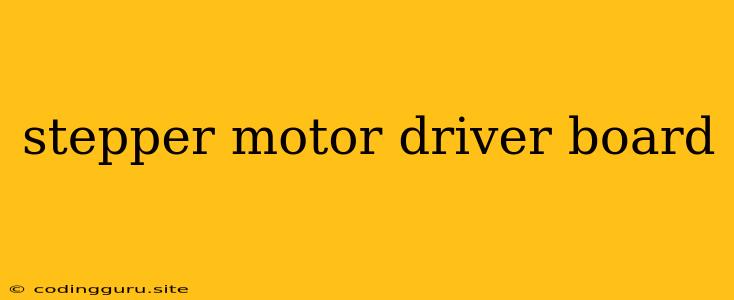Stepper Motor Driver Boards: Your Guide to Precise Motion Control
Stepper motors are widely used in various applications for their precise and controlled motion capabilities. However, directly connecting a stepper motor to a microcontroller can be challenging. This is where stepper motor driver boards come in. These boards act as intermediaries between the microcontroller and the stepper motor, providing the necessary power amplification, control signals, and protection mechanisms to ensure smooth and reliable operation.
What is a Stepper Motor Driver Board?
A stepper motor driver board is an electronic circuit designed to drive stepper motors. It receives commands from a microcontroller or other control unit and translates them into signals that control the stepper motor's movement. Essentially, it serves as an interface between your microcontroller and the stepper motor, simplifying the process of controlling the motor's direction, speed, and position.
Why Do You Need a Stepper Motor Driver Board?
- Current Amplification: Stepper motors require significant current to operate, typically exceeding the output capacity of microcontrollers. A stepper motor driver board amplifies the current, ensuring adequate power to drive the motor efficiently.
- Signal Conditioning: Microcontroller signals are often low voltage and may not be compatible with the stepper motor's requirements. The driver board converts these signals into appropriate levels and timing for the motor.
- Protection: Stepper motors can generate high back EMF (electromotive force) during operation. The driver board includes protection mechanisms to prevent damage to the microcontroller and motor due to this back EMF.
- Control Features: Stepper motor driver boards offer features such as microstepping, which allows for smoother and quieter operation, and current control, which can optimize motor performance and efficiency.
Key Features to Consider in a Stepper Motor Driver Board
- Stepper Motor Compatibility: Make sure the driver board supports the type of stepper motor you plan to use. Factors like voltage, current, and motor winding configuration (unipolar or bipolar) are important considerations.
- Current Output: Select a driver board with sufficient current output to meet the motor's requirements.
- Microstepping Resolution: Higher microstepping resolutions result in smoother and quieter operation.
- Control Interface: Consider the communication interface offered by the driver board. Common options include SPI, I2C, or parallel control.
- Voltage Input: Choose a driver board compatible with your power supply voltage.
- Protection Features: Features like overcurrent protection, overvoltage protection, and thermal shutdown enhance the driver board's reliability.
Types of Stepper Motor Driver Boards
- L298N: A popular and versatile driver board that can control two stepper motors. It is relatively inexpensive and easy to use.
- A4988: A high-performance driver board with features like microstepping and overcurrent protection.
- DRV8825: A robust driver board known for its high current output and advanced features, including current control and thermal shutdown.
- TMC2209: A driver board with advanced features like stealthChop technology for extremely quiet operation and dynamic current control for optimized efficiency.
Tips for Using a Stepper Motor Driver Board
- Read the Datasheet: Thoroughly understand the driver board's specifications and features.
- Match the Driver to the Motor: Choose a driver board with adequate current capacity and compatibility with your stepper motor.
- Proper Connections: Connect the driver board to the stepper motor and microcontroller according to the datasheet.
- Start Slowly: When testing, start with low speeds and gradually increase them to avoid overloading the motor.
- Calibrate Microstepping: If the driver board offers microstepping, calibrate it based on the motor's characteristics for optimal performance.
Real-World Applications of Stepper Motor Driver Boards
Stepper motor driver boards are used in various applications, including:
- 3D Printers: For precise and reliable motion control of the printing head.
- CNC Machines: For controlling the movement of tools and materials in machining processes.
- Robotics: For accurate movement of robotic arms and other components.
- Medical Devices: In medical equipment that requires precise and controlled motion, such as pumps and surgical instruments.
- Industrial Automation: In industrial automation systems, where precise positioning and movement are crucial.
Conclusion
Stepper motor driver boards are essential components for controlling stepper motors effectively. They simplify the process by providing current amplification, signal conditioning, protection mechanisms, and advanced control features. By carefully considering the features and specifications of different driver boards, you can choose the ideal solution for your specific project.
